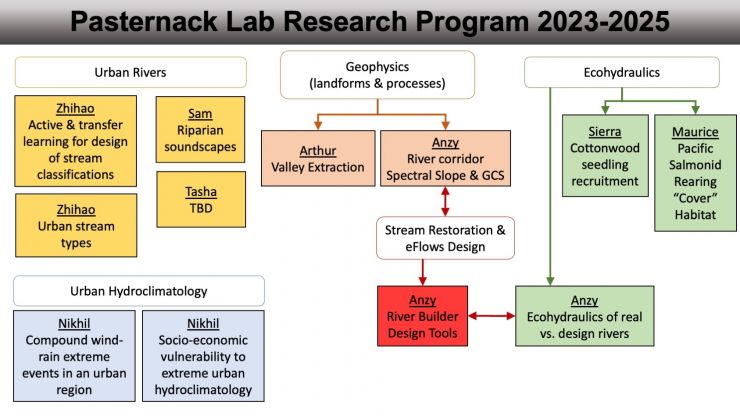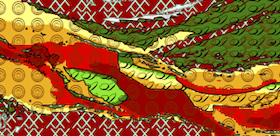Welcome to the Pasternack Lab.
We help society manage and restore hydrogeomorphic processes in support of enhanced ecosystem functioning. We do this through a combination of (i) basic physical and ecological science to understand how the naturally complex landscape works, (ii) development of methods and software for designing more natural, functional environments, and (iii) technology transfer to get concepts, methods, and results into the hands of practitioners, regulators, and stakeholders. Research is also balanced with teaching, service, and outreach.
This website's development was supported by the USDA National Institute of Food and Agriculture, Hatch project number CA‐D‐LAW‐7034‐H.
Please choose an item from the menu to the left or click on any image or link on this page to learn more.
Featured Video:
For more information on the science and activity behind the gravel augmentation project shown in the video above, see the gravel/cobble injection web page.
Professor Pasternack has 3 YouTube channelS:
- Channel with academic lectures: Lectures link
- Channel with general interest videos: RiverSciLife link
- Ecohydraulics community videos: Ecohydraulics link
Latest Teaching Developments
Professor Pasternack is on sabbatical for the 2024-2025 academic year.
Classes that will be taught in 2025-2026 will include SAS004 (fall), HYD254 (fall), and HYD143 (winter).
HYD151 was discontinued as of 2020. It was a great journey over 21 years, but now I have created the new River Conservation course (ESM125) and I can teach a virtual field methods class given enough demand. I hope my department will decide to value field-oriented courses and assign a field methods class on to the next generation of colleagues.
Latest Lab Group Developments
- Heading into Fall 2024 there are 2 postdoctoral researchers (hydroclimatology and Eatth data science), 2 PhD students, 2 MS students, 4 seasonal technicians, and 2 undergraduate researchers.
- Recent articles have been investigating geomorphic processes, fish migratory behavior, and machine learning prediction of stream types.
- This year I am leading a $2 mln interdisciplinary, transdisciplinary program addressing unhoused folks and fish habitat coexisting in urban stream corridors subjected to climate-change-enhanced flash floods.
Latest Research Developments:
The schematic below shows a broad overview of current Pasternack Lab research projects by topic name and lead researcher. Over the years, research lines develop based on researcher interest and availabile funding, so while there is some general steering of the whole program through submission of large grant proposals, a lot of what happens hinges on each person's contributions.

Looking beyond the schematic, here is a list of some of the broad research questions we are actively pursuing at this time, in no particular order:
Fundamental quesitons:
- What are the details of the mechanisms by which rivers change their shape and to what extent does hydrology and topography control these mechanisms?
- What physical habitats do aquatic and riparian organisms need and how do those habitats change as a funciton of river discharge and topographic change?
- What is the role of organized variability in river form, process, and links with ecology?
Applied questions:
- What is the geomorphic sustainability and ecological functionality of commonly engineered river restoration features?
- What environmental flows should be released to support rivers of different types?
- How can we design more natural rivers for the many situations in which we need to build rivers from scratch or significantly recontour existing rivers.
The above list is not all-inclusive, but it highlights the big picture of the scope of work we are actively doing.
Featured Projects:
Links to all projects can be found on the Projects web page. Here are some direct links to some projects we are doing right now.
River Builder
World's first open-source, procedural software for creating river terrains exactly to specification.
Geomorphic Covariance Structures
The fundamental bivariate linkages among river variables.
eFlows
Explore and visualize California's unimpaired streamflow patterns.
River Architect
Python platform for ecohydraulic and geomorphic river & river design analysis.
Near-Census River Science
Spatially explicit, process studies using 1-m scale as the basic building block for river science.
Channel Types
Classification and analysis of California's channel types to aid river management.
















